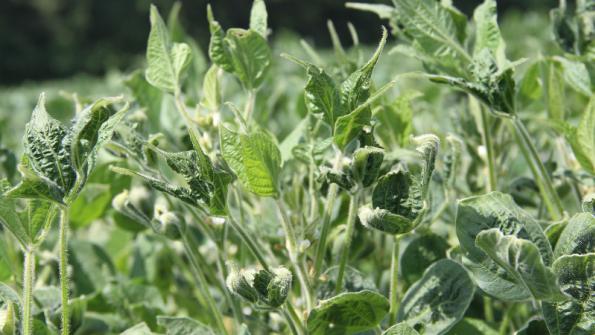
Before getting to the meat and potatoes of his presentation at Pigposium 3 on Feb. 28, Jason Bond advised the audience of several caveats.
“I spend 95 percent of my time in the Northwest District of Mississippi, which comprises 19 counties in the Delta,” said the Mississippi State University weed specialist. “So, that’s from Tunica County, right below Memphis, all the way to I-20 in Vicksburg. Of those 19 counties, there is only PPO resistance in five of them – nothing like you see in northeast Arkansas.”
Bond didn’t downplay the seriousness of what Mid-South producers are facing with herbicide-resistant pigweed. “I know the magnitude of the situation you’re facing. Our guys (in Mississippi) aren’t there yet. I’m not saying we won’t get there but it isn’t at the same problem level yet.
“So, you will see some things (in my presentation) that don’t apply in a PPO-resistant situation.
“Secondly, I’m not going to show you much about efficacy comparing these technologies. … In the absence of PPO resistance, I think I can make a case for using any of these technologies from Roundup Ready all the way through the two new ones effectively. So, rather than spend time on efficacy, I’ll unpack some of things that come along with using these technologies and what we run into with the labels.”
Enlist, said Bond, “probably won’t be a full launch in soybeans this year. They’ll focus on cotton in 2017 and, hopefully, ramp (soybeans) up for 2018.”
In Mississippi, there are three herbicides labeled for application in the Xtend system: XtendiMax with VaporGrip, Engenia and Fexapan plus VaporGrip.
“Fexapan is a Dupont product with a label that reads almost identically to the XtendiMax label – they’re very similar. The key point on all three of these is they’re dicamba-only products. There is no premix with a nonselective herbicide.
“Roundup Xtend is a premix of glyphosate with dicamba. It’s unknown when we’ll have access to it. It’s similar to Enlist Duo, which is a premix containing glyphosate and 2,4-D choline.”
For soybeans, there’s “a big, fundamental difference” between the Xtend and Enlist systems. “With Enlist, if we’re using it today, we could use glyphosate, glufosinate (Liberty), and the 2,4-D choline, which is the base of the system.”
With the Roundup Xtend system you can use glyphosate and dicamba -- but you can’t use glufosinate. “There’s been a great deal of confusion on that. A source of that, I think, is in the Bollgard II XtendFlex cotton the option is there to use all three.”
NO CROSS-RESISTANCE
For those who have been following the development of these programs “this may seem elementary, but for those just becoming familiar with them another source of confusion is there’s no cross-resistance between the systems. Enlist Duo will kill or injure Xtend and dicamba will kill or injure Enlist crops.
“In Mississippi, if I go south of Highway 82 towards Vicksburg or Yazoo City, this is the system being used: Flexstar GT or glyphosate plus Prefix. That’s the mainstay at that latitude.
“Heading farther north, you start picking up LibertyLink acres.”
All those products are labeled pre-, all are labeled post. “The cutoffs, within reason, are about the same. The one that does cause me a bit of concern is the R-1 cutoff for the dicamba products in Xtend crops is different than that for glyphosate. So, if we ever are able to mix those two, it’s a bit frustrating to have two different cutoffs for a post-emergence application. In the end, the difference between R-1 and R-2 isn’t that great.”
What about weed size at application?
“If you read the Flexstar GT or Liberty labels, there’s a range. We know Liberty will kill some species as big as the hood of a truck. Other species it isn’t as strong on. Flexstar is the same way. But we know if we try to kill Palmer amaranth that’s much bigger than 4 inches, we won’t have sustained success with either of those products.
“On the dicamba and Enlist Duo labels, they give specific sizes. The dicamba products are very specific to the point where XtendiMax and Fexapan say those products won’t be warranted if an application is made to a weed larger than 4 inches.
“The point is, in the absence of PPO resistance, you can’t kill a bigger Palmer amaranth with dicamba or 2,4-D choline than you can with Liberty. Take Flexstar out of the picture. You might a kill 6- or 7-inch Palmer at 70 to 80 percent – but that won’t happen consistently.”
What are the requirements and cautions on rainfall and irrigation free periods with the products?
Flexstar GT: Rainfall shortly after application may reduce performance.
Liberty 280: Rainfast for four hours following application.
XtendiMax Fexapan: Rainfast is four hours. Do not make application if rain is expected in the next 24 hours.
Engenia: Rainfast is four hours. Postemergence activity may be reduced if rain or irrigation occurs within four hours of application.
Enlist Duo: Do not make application if rain is expected within 24 hours. Do not irrigate treated fields for at least 24 hours after application.
About the Author(s)
You May Also Like




